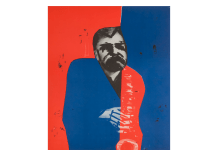Part II of a Three-Part Story
James in NEON
Most of James’ neon pieces
were already touching upon
innovative functionality. There
were no other artists doing
this type of intense design at
the time. It was as if by some
divine act James was possessed
with an innate ability. Charles
Fine remembers James when
he was in his twenties. Charles
an artist in his own right works
with galleries and collectors
who show contemporary art.
He creates exotic works with
paint and sculpting in bronze.
Fine had this to say about
McDemas: “James was working
for Greg Abbott who was
known for fabrication and metal
design. We were in an industrial
park at the time and I had my
own studio. My work is contemporary
art and involved a big
studio, where I had my paints
and sculpting and James was
working with metal and steel
restoration. Greg introduced
us and we started hanging out.
I believe that part of the attraction
was my studio size and all
of the types of materials I used
for my work. James gathered
light bulbs and other fixtures
from various locations and
would take them over to his studio
in Culver City. He cruised all
over Los Angeles taking donations
from companies in the
San Fernando Valley, Pacoima,
Burbank and Glendale, which
were going out of business. He
found particular interest in 50’s
and 60’s signage. For him it was
like going on a treasure hunt. I
refer to him as a preservationist.
Many of those pieces would
have been in land-fields now,
had it not been for James. He
loved the old signage of Southern
California.
“He was my assistant for a
while and helped me to realize a
number of my projects. By this
I mean, he took what I showed
him and was able to perfect it. If
I needed tools, he got them for
me. He would help me at times
to complete my ideas and was
able to complete projects meticulously
and with perfection. He
was much younger than I was,
and I opened his eyes to different
mediums that I used for my
contemporary work. His presence
was always so calm. He
was quiet and diligent. James
was good at taking directions
and processes on artwork that
I would realize .He assisted
me on certain aspects of labor
on projects that required more
than one person. He would
help to structure the piece and
I would lay my work on top of
that. He had learned welding
and how to cut and shape steel
from Greg Abbott and enjoyed
working in a completely
abstract studio environment.
I do feel that what he encountered
in my studio he used and
began to add into his work of
small objects and sculptures.
“I would stop by his studio
from time to time because I was
only about three miles inland;
he was right up under the 405
and so it was easy to get over
there. He was fabricating and
making functional art at Marmol
Radziner then. Marmol
takes high-end new residences
from prominent mid-century
modern architecture and
restores them. James worked
on a number of projects for
them, like exquisite fireplace
screens, door poles, mailboxes
all fabricated beautifully and
meticulously. He had input into
many of their designs. I would
pick him up from St. John’s
Hospital and he always seemed
to be in good spirits, had a positive
outlook, and focused on
his work. He gave the hospital
some nice art pieces. We hung
out right up until the end.”
MONA the museum of
neon art and James were fated
to meet. As more and more
of James talent began to surface,
he started to shift from
local artist to celebrity status.
McDemas deepened his talent
scratching only the surface of
what was to become his personal
brand of neon art. Let me
explain: we’re talking comic
books, dolls and not just Barbie,
toys, cooking utensils, oil
cans, American flags, chairs,
restaurant menus, ironing
boards, scarves and handkerchiefs;
stamps, coins keys,
letters, anything that could
create a cleverly crafted art
piece. http://www.neonmona.
org/sign-restoration/pdf/signrestore-
white150dpi.pdf. For
those of you who may not realize
how much work goes into
restoring a NEON sign, MONA
provides a downloadable pdf
via the link above. MONA is
the only museum in the world
dedicated to neon, electric and
kinetic art. MONA houses
most of the McDemas neon
pieces and recently purchased
his famous sign ART. MONA
restores signs with great consideration
to the condition of
each sign, its age, and history.
The signs are left as intact as
possible with minimal changes
beyond cleaning, replacing
broken glass units, wiring and
transformers and painting as
needed.
Charles and Ray Eames
made the lounge chair and ottoman
as a gift for their friend,
Billy Wilder, the director of
“Some Like It Hot” and “Sunset
Blvd” their simplistic yet elegant
style influenced James. In
fact, some called James a baby
Eames because of the multimedia
and three-dimensional
aspect of his work. Charles
would have been 106 years old
now. Ultimately, both of them
became a pair of names that
resonate as a singular, legendary
entity. Their collaborative
body of work came to reflect
all the modernist qualities
of Charles’s straightforward
prose: purity, and efficiency.
This is the end of Part II of a
three-part story.












